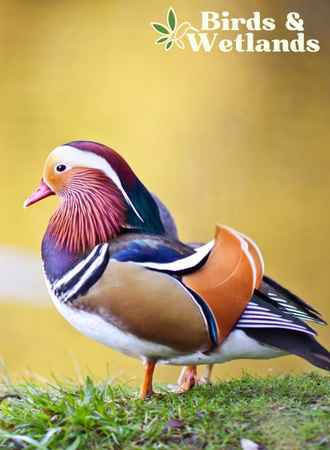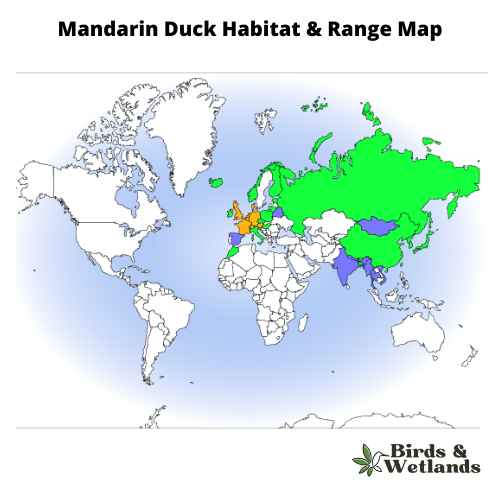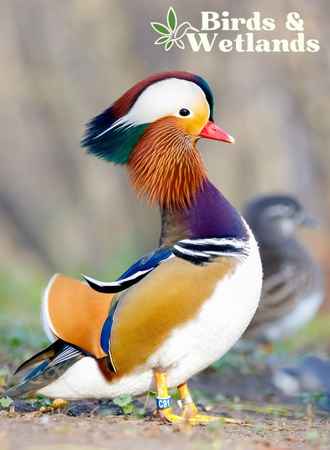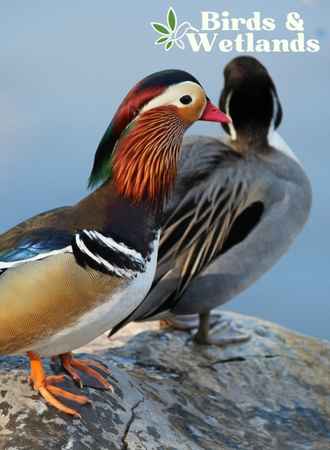The Mandarin duck (Aix galericulata) is a small perching duck native to East Asia, primarily found in China, Japan, and Korea but now also appearing in Europe.
It is known for its beautiful colorful plumage, reddish face and red beak, which is why they are often kept as ornamental birds in parks and gardens.
Mandarin ducks are often seen perched on logs and tree branches.
Scientific Name: Aix galericulata
Height: 41–49 cm (16–19 in)
Wingspan: 65–75 cm (26–30 in)
Weight: 430 – 690 g
Physical Description
The adult male Mandarin duck is a stunningly beautiful bird with unique plumage. It has a bright red bill with a large white crescent above the eye, giving it an almost mischievous expression. Its reddish-brown face has whiskers-like feathers and a purple crest at the back of the head.
Its breast is an impressive deep purple color and features two vertical white bars and orange sails.
The area around its wings and along its sides or flanks is a rich reddish-brown hue. Two striking orange feathers stick up from the back of its head, resembling boat sails.
On the other hand, the female Mandarin duck is more subtly colored than her male counterpart but still quite attractive. She has a white eye-ring and a stripe running back from the eye, bordered by pale colors on the rest of her body.
Her bill has a light tip, while her ground color is paler than the male. The lower part of her body also features two short white stripes along its flanks that contrast against her earthy tones.

Habitat & Range
The Mandarin duck is a bird species that breed in eastern Russia, Japan, and parts of China, wintering in South Korea, Taiwan, and southern Japan.
Mandarin ducks live in forests near shallow lakes, fresh water marshes, coastal lagoons or ponds with dense vegetation for cover. They make their nests in old tree cavities or on the ground among dense shrubbery.
Mandarin ducks are shy birds but can be seen swimming in small groups of other ducks during the breeding season. In addition to living in wetlands, they can also be found along fast-flowing rivers, cultivated areas, flooded fields and streams, where they feed on aquatic insects, such as dragonflies and snails.
During the non-breeding season, they migrate to coastal estuaries, flooded meadows, and reservoirs, where they consume plant material, such as seeds and aquatic vegetation.
The Mandarin duck has become an introduced species outside of its native range. For example, a small population exists in North Carolina, Berlin and Ireland. The introduced European range, including the British population, breeds near shrubby forested edges of lakes and rivers with plenty of overhanging trees.

Behavior & Diet
Mandarin ducks are omnivorous, meaning they eat both plant and animal matter. They are active feeders, foraging mainly near dawn or dusk but resting in trees or on the ground during the day.
Mandarin ducks typically forage for food in open habitat which include shallow water, water meadows, open rivers or on land. They dabble in the water with their beaks to uncover aquatic insects, crustaceans, fish eggs, and other small prey.
On land, they may walk along the ground or pick through leaf litter in search of seeds, shoots, fruits, and other vegetation types. Mandarin ducks also scavenge along rivers and lakes for worms, snails, spiders, and other insects.
The exact composition of a Mandarin duck’s diet may vary depending on the season and the availability of food sources.
In the fall and winter, they mostly eat acorns and grains, while in the spring, they may consume more insects, snails, small fish, and aquatic plants. They may also eat dew worms, frogs, and even small snakes in the summer.

Nesting & Mating Habits
Mandarin Ducks breed in densely wooded areas near water. During the mating season, females build nests in tree cavities and hollows near lakes, marshes, or ponds with woods nearby.
The female lays a clutch of 9 to 12 eggs and incubates them alone. The male leaves the female shortly before the incubation begins to join other males to molt into their eclipse plumage.
Within 24 hours after the ducklings hatch, the female leads her ducklings to water, where they live until adulthood. Mandarin Ducks sometimes travel up to 35 miles away from their nesting sites to find food, even though they are solitary birds.

Threats & Conservation
The estimated global population is 65,000 to 70,000 birds. The current conservation status of the Mandarin duck is “Least Concern” and not part of the IUCN Red List of Threatened Species. Still, these colorful ducks are facing threats.
Unfortunately, this species is rapidly declining in population due to habitat destruction, overhunting, egg collection, and pollution. Conservation efforts are underway to protect these ducks from extinction.

Fun Facts
- The Mandarin duck is widely regarded as the most beautiful duck in the world.
- Mandarin ducks are often associated with love and marriage. In China and the Far East, the ducks symbolize fidelity, life-long pair bonds and are often given as gifts to newlyweds.
- The Mandarin duck is a common subject of many oriental art pieces.
Key Points
- Female Mandarin ducks lay between nine to twelve eggs.
- Mandarin ducks eat insects, fish and plants.
- Upon hatching, ducklings jump out of the nest and to the ground.

